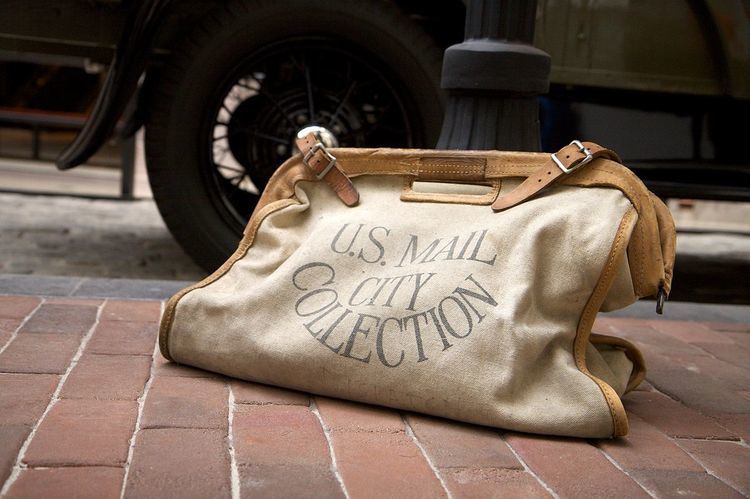 | ||
A mail bag or mailbag is a generic term for a type of bag used for collecting, carrying, categorizing, and classifying different types of postal material, depending on its priority, destination, and method of transport. It is oftentimes used by a post office system in transporting these different grades of mail. The mailbag is carried by some means of transporting like a mail carrier, animal (e.g., mule, horse), or a mobile post office. Letters and printed material delivered by mail in the seventeen-hundreds were carried by horse in a saddle bag. There are several different types of mailbags for different purposes (e.g., transporting mail to and from post offices, delivering mail to businesses and homes. These different styles of mailbags depend on its size and purpose. It can range from "a large bag used for transporting mail on a truck, plane, etc." to a simple "postbag" used by a mail carrier to deliver mail.
Contents
- Types
- Mail sacks
- Mail satchel
- Mail pouch
- Catcher pouch
- Mochila
- Portmanteau
- Mailbag in popular culture
- References
The idea of having mail bags on board ships traveling between Jamaica and Great Britain was established as early as 1780. The name of the ship carrying a letter was put on the corner of the letter so that it would be put into the proper mail bag for the destination intended.
A mailbag throughout the United States history has been called various names depending on its form and function at the time, some of which are now obsolete. Among these names are mail sack, mail satchel, mail pouch, catcher pouch, mochila, and portmanteau.
Private Mail Bags or so-called "Locked Bags" are a worldwide solution for specialized mail delivery to a single location. Like PO Box addresses, Private Mail Bag addresses omit the name of the building and street, and include only the number allocated to the user. Private Mail Bag addresses are often used in countries in Africa where there may be no street delivery service. In Europe and North America, where street delivery is more commonplace, large users may be allocated their own postal codes, and consequently need only use their physical address in correspondence; the postal code implies that the recipient receives mail by caller service. Private mail bags may be in lieu of a Post Office Box, but sometimes can go so far as to have an individualized corporate zip code.
Types
The U.S. National Postal Museum says that any bag that carries mail (e.g., letters, magazines, advertisement brochures, packages) is defined as a "Mailbag". A mailbag is called a postbag in England. The form and structure of mailbags has implications for fatigue and industrial injuries to mail carriers.
Mail sacks
A mail sack is a lower security class mailbag used to carry second-class, third-class, and fourth-class mail. It does not have a locking mechanism with it.
Mail satchel
A mail satchel is a device letter carriers use over-the-shoulder for assisting the delivery of personal mail to businesses and homes.
Mail pouch
A mail pouch is a strong material (e.g., canvas) mail bag designed to lock at the top to prevent access into the bag. They are usually used for transporting First-class and registered mail to and from different post offices. Mail pouches also carry military domestic and military airmail.
Catcher pouch
A catcher pouch was a mail bag used only by the Railway Post Office in exchanging mail when the train did not stop at the town. It was most popular in the late nineteenth century and the early twentieth century.
Mochila
A mochila was a removable lightweight leather cover put over a horse saddle for carrying mail and was used by the Pony Express.
Portmanteau
A portmanteau was a traveling suitcase used as a mailbag in the eighteenth and nineteenth centuries to carry both letters and newspapers. When it opened it had two different compartments, one for letters and the other for newspapers.
